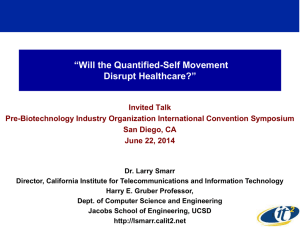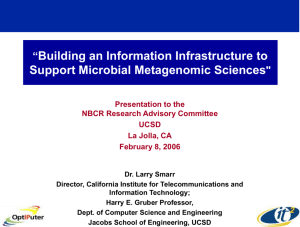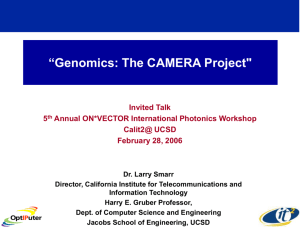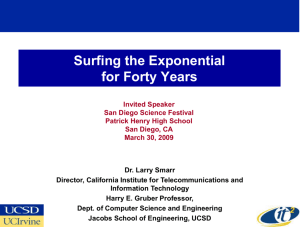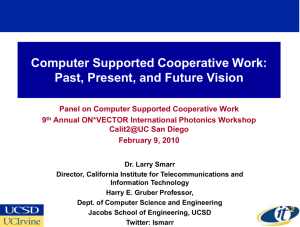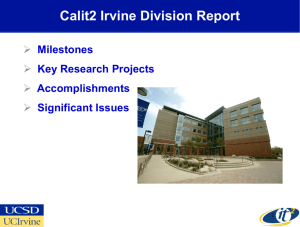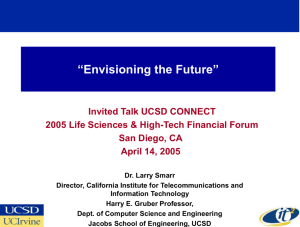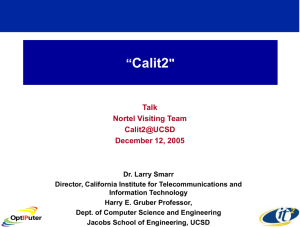PPT - Larry Smarr - California Institute for Telecommunications and
advertisement
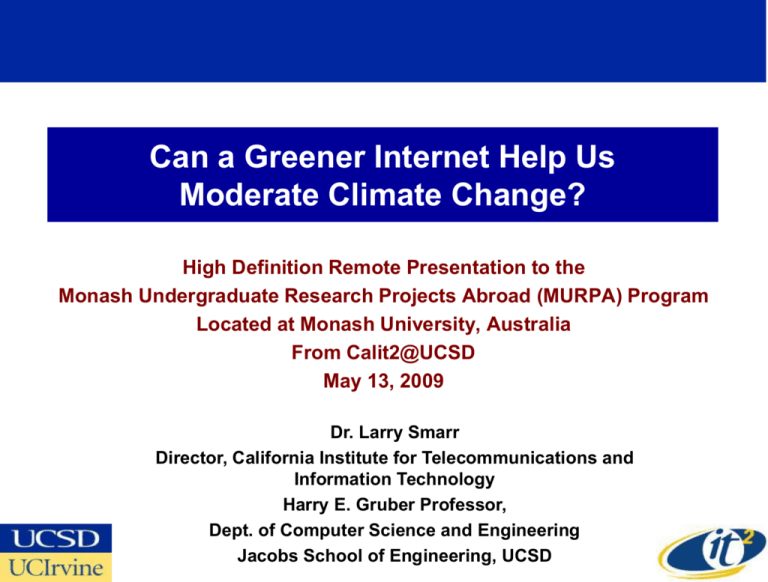
Can a Greener Internet Help Us Moderate Climate Change? High Definition Remote Presentation to the Monash Undergraduate Research Projects Abroad (MURPA) Program Located at Monash University, Australia From Calit2@UCSD May 13, 2009 Dr. Larry Smarr Director, California Institute for Telecommunications and Information Technology Harry E. Gruber Professor, Dept. of Computer Science and Engineering Jacobs School of Engineering, UCSD Abstract This year marks a turning point in the debate on global climate change. The focus of the discussion is rapidly moving from a scientific analysis of how human activity effects climate change to a political process on how best to regulate greenhouse gas emissions. The Climate Group’s Smart 2020 study reveals that the global Information and Communication Technology (ICT) industry produces greenhouse gases equivalent to that produced by the aviation industry (~2-3 percent). Furthermore, the ICT sector’s emissions will nearly triple, in a business-as-usual scenario, from 2002 to 2020. On the other hand, the Climate Group estimates that transformative applications of ICT to electricity grids, logistic chains, intelligent transportation and building infrastructure, and other social systems can reduce global greenhouse gas emissions by about 15 percent— five times ICT’s own footprint! I will discuss initiatives on university campuses in the US and Australia to innovate new solutions to these challenges. The Planet is Already Committed to a Dangerous Level of Warming Temperature Threshold Range that Initiates the Climate-Tipping Earth Has Only Realized 1/3 of the Committed Warming Future Emissions of Greenhouse Gases Move Peak to the Right Additional Warming over 1750 Level V. Ramanathan and Y. Feng, Scripps Institution of Oceanography, UCSD September 23, 2008 www.pnas.orgcgidoi10.1073pnas.0803838105 Atmospheric Aerosols Cool Climate— Cleaning Air Pollution will Accelerate Warming! Ramananthan & Feng www.pnas.orgcgidoi10.1073pnas.0803838105 Outside Beijing 11/9/2008 NASA satellite image Arctic Summer Ice is Rapidly Decreasing “The Arctic Ocean will be effectively ice free sometime between 2020 and 2040, although it is possible it could happen as early as 2013.” --Walt Meier, Research Scientist at the National Snow and Ice Data Centre at the University of Colorado http://news.cnet.com/8301-11128_3-10213891-54.html The Hindu Kush/Himalayan Plateau Has the Most Snow and Ice Outside of the Polar Regions “Water Towers of Asia” Impact 40% of the World’s Population “California Faces Water Rationing, Governor Proclaims Drought Emergency” --February 27, 2009 California and Himalayan Asia: Snow and Ice are Critical Fresh Water Reservoirs NASA Blue Marble Data Set January 2004 Falko Kuester, HiPerSpace, Calit2 Australia, the U.S., and Canada Share a Problem: Top 3 Developed Countries For Per Capita GHG Emission “Australia’s Total Emissions Exceed Those of France and Italy” --Australia Institute http://en.wikipedia.org/wiki/File:GHG_per_capita_2000.svg Countries and States are Setting Aggressive Greenhouse Gas Reduction Goals "Australia is today the biggest carbon polluter in the developed world on a per capita basis, yet we are the developed country with the most to lose from climate change. Without action on climate change, Australia faces a future of parched farms, bleached reefs, and empty reservoirs." --Australian Prime Minister Kevin Rudd www.guardian.co.uk/environment/2008/dec/15/climate-change-australia “It Will Be the Biggest Single Peacetime Project Humankind Will Have Ever Undertaken” The IPCC Recommends a 25-40% Reduction Below 1990 Levels by 2020 • On September 27, 2006, Governor Schwarzenegger signed California the Global Warming Solutions Act of 2006 – Assembly Bill 32 (AB32) – Requires Reduction of GHG by 2020 Only to 1990 Levels – 10% Reduction from 2008 Levels; 30% from BAU 2020 Levels – 4 Tons of CO2-equiv. Reduction for Every Person in California! • The European Union Requires Reduction of GHG by 2020 to 20% Below 1990 Levels (12/12/2008) • Australia has Pledged to Cut by 2020 its GHG Emissions 5% from 2000 Levels via the World's Broadest Cap &Trade Scheme (12/15/08) [~5% Below 1990 Levels] • Neither the U.S. or Canada has an Official Target Yet – President Obama Has Endorsed the AB32 2020 Goal ICT is a Critical Element in Achieving Countries Greenhouse Gas Emission Reduction Targets GeSI member companies: • Bell Canada, • British Telecomm., • Plc, • Cisco Systems, • Deutsche Telekom AG, • Ericsson, • France Telecom, • Hewlett-Packard, • Intel, • Microsoft, • Nokia, • Nokia Siemens Networks, • Sun Microsystems, • T-Mobile, • Telefónica S.A., • Telenor, • Verizon, • Vodafone Plc. Additional support: • Dell, LG. www.smart2020.org The Global ICT Carbon Footprint is Roughly the Same as the Aviation Industry Today But ICT Emissions are Growing at 6% Annually! Most of Growth is in Developing Countries the assumptions behind the growth in emissions expected in 2020: • takes into account likely efficient technology developments that affect the power consumption of products and services • and their expected penetration in the market in 2020 www.smart2020.org Reduction of ICT Emissions is a Global Challenge – U.S. and Canada are Small Sources U.S. and Canada Together Fall From 25% to 14% of Global ICT Emissions by 2020 www.smart2020.org The Global ICT Carbon Footprint by Subsector The Number of PCs (Desktops and Laptops) Globally is Expected to Increase from 592 Million in 2002 to More Than Four Billion in 2020 www.smart2020.org A System Approach is Required to Reduce Internet’s Greenhouse Gas Emissions • • Estimates Needed for CO2 Emissions from Each Subcomponent Beware of Tradeoffs: – “I will clean up my campus by getting rid of clusters and computing in the cloud” – Is This a Net Reduction? Source: Rod Tucker, U Melbourne Electricity Usage by U.S. Data Centers: Emission Reductions are Underway Source: Silicon Valley Leadership Group Report July 29, 2008 https://microsite.accenture.com/svlgreport/Documents/pdf/SVLG_Report.pdf The NSF-Funded GreenLight Project Giving Users Greener Compute and Storage Options UCSD Structural Engineering Dept. Conducted Sun MD Tests May 2007 • Measure, Publish, and Control Energy Usage: – – – – – Sun Has Shown up to 40% Reduction in Energy Active Management of Disks, CPUs, etc. Measures Temperature at 5 Levels in 8 Racks Power Utilization in Each of the 8 Racks Chilled Water Cooling Systems Source: Tom DeFanti, Calit2; GreenLight PI UCSD (Calit2 & SOM) Bought Two Sun MDs May 2008 GreenLight’s Data is Available Remotely: Virtual Version in Calit2 StarCAVE 30 HD Projectors! Connected at 50 Gb/s to Quartzite Source: Tom DeFanti, Greg Dawe, Jurgen Schulze, Calit2 Calit2’s GreenLight Project Receives CENIC’s 2009 Innovations in Networking Award--Experimental-Developmental Applications www.calit2.net/newsroom/release.php?id=1485 Research Needed on How to Deploy a Green CI MRI • Computer Architecture – Rajesh Gupta/CSE • Software Architecture – Amin Vahdat, Ingolf Kruger/CSE • CineGrid Exchange – Tom DeFanti/Calit2 • Visualization – Falko Kuster/Structural Engineering • Power and Thermal Management – Tajana Rosing/CSE • Analyzing Power Consumption Data – Jim Hollan/Cog Sci • Direct DC Datacenters – Tom Defanti, Greg Hidley http://greenlight.calit2.net New Techniques for Dynamic Power and Thermal Management to Reduce Energy Requirements NSF Project Greenlight • Green Cyberinfrastructure in Energy-Efficient Modular Facilities Closed-Loop Power &Thermal Management • Dynamic Power Management (DPM) • • Optimal DPM for a Class of Workloads Machine Learning to Adapt • Select Among Specialized Policies • Use Sensors and Performance Counters to Monitor • Multitasking/Within Task Adaptation of Voltage and Frequency • Measured Energy Savings of Up to 70% per Device Dynamic Thermal Management (DTM) • Workload Scheduling: • Machine learning for Dynamic Adaptation to get Best Temporal and Spatial Profiles with Closed-Loop Sensing • Proactive Thermal Management • Reduces Thermal Hot Spots by Average 60% with No Performance Overhead System Energy Efficiency Lab (seelab.ucsd.edu) Prof. Tajana Šimunić Rosing, CSE, UCSD GreenLight Project: Putting Machines To Sleep Transparently Rajesh Gupta, UCSD CSE; Calit2 Network interface Secondary processor Management software Network interface Low power domain Peripheral Main processor, RAM, etc IBM X60 Power Consumption Somniloquy Enables Servers to Enter and Exit Sleep While Maintaining Their Network and Application Level Presence Power Consumption (Watts) Laptop 20 16W (4.1 Hrs) 18 16 11.05W (5.9 Hrs) 14 12 10 8 6 4 2 0.74W (88 Hrs) 1.04W (63 Hrs) Sleep (S3) Somniloquy 0 Baseline (Low 23 Power) Normal GreenLight Provides a Environment for Innovative “Greener” Products to be Tested Quadrics Was Designed to Use 20% and 80% Less Power per Port Than Other Products in the 10 GigE Market www.calit2.net/newsroom/article.php?id=1482 Consolidating Dispersed Faculty Clusters Over the Fiber Connected UCSD Campus Research CI SDSC Triton Components Cluster Condo HPC System PetaScale Data Analysis Facility UC Grid Pilot DNA Arrays, Mass Spec., Microscopes, Research Genome Instrument Sequencers Digital Collections Lifecycle Management UCSD Storage Research Cluster N x 10Gbe Source: Phil Papadopoulos, SDSC/Calit2 OptIPortal Power Management in the Cellular Infrastructure: Calit2 Team Achieves 58% Power Amplifier Efficiency Standard Commercial Base Station Power Amp is 10% Efficient Calit2 High-Power Amplifier Lab Power Transistor Tradeoffs: Si-LDMOS, GaN, & GaAs Price & Performance Power Amplifier Tradeoffs: WiMAX & 3.9GPP LTE Efficiency & Linearity STMicroelectronics Digital Signal Processing Tradeoffs: Pre-Distortion, Memory Effects & Power Control MIPS & Memory www.universityofcalifornia.edu/news/article/19058 Source: Don Kimball, Calit2; Peter Asbeck and Larry Larson, ECE Leading Edge Photonics Systems Laboratory Has Demonstrated Multiple World Records • Networking “Living Lab” Testbed Core – – – – – Terabit Networking Micro LIDAR/Spectroscopy Silicon Frequency Conversion 320Gbps Real Time Processing Advanced Transmission Coding Stojan Radic ECE Testbed Faculty Optical communication networks; all-optical processing; parametric processes in high-confinement fiber and semiconductor devices. George Papen Advanced photonic systems including optical communication systems, optical networking, and environmental and atmospheric remote sensing. Joseph Ford Optoelectronic subsystems integration (MEMS, diffractive optics, VLSI); Fiber optic and free-space communications. Shaya Fainman Nanoscale science and technology; ultrafast photonics and signal processing Shayan Mookherjea Optical devices and optical communication networks, including photonics, lightwave systems and nano-scale optics. UCSD Photonics Application of ICT Can Lead to a 5-Fold Greater Decrease in GHGs Than its Own Carbon Footprint While the sector plans to significantly step up the energy efficiency of its products and services, ICT’s largest influence will be by enabling energy efficiencies in other sectors, an opportunity that could deliver carbon savings five times larger than the total emissions from the entire ICT sector in 2020. --Smart 2020 Report Major Opportunities for the United States* – – – – Smart Electrical Grids Smart Transportation Systems Smart Buildings Virtual Meetings * Smart 2020 United States Report Addendum www.smart2020.org Real-Time Monitoring of Building Energy Usage: UCSD Has 34 Buildings On-Line http://mscada01.ucsd.edu/ion/ Comparision Between UCSD Buildings: kW/sqFt Year Since 1/1/09 Calit2 and CSE are Very Energy Intensive Buildings Power Management in Mixed Use Buildings: The UCSD CSE Building is Energy Instrumented • 500 Occupants, 750 Computers – More Computers Than Humans! • Detailed Instrumentation to Measure Macro and Micro-Scale Power Use – 39 Sensor Pods, 156 Radios, 70 Circuits – Subsystems: Air Conditioning & Lighting Calit2 is Being Re-Designed as an “Internet of Things” Building Source: Rajesh Gupta, CSE, Calit2 Making Cars Greener Requires Software Engineering-Calit2 Established the Automotive Software Workshop Source: Ingolf Krueger, Calit2 90 % of all Auto Innovations are Now Software-Driven • Over 10 Million Lines of Code in Your Car! • Sponsors: Calit2, NSF, EU, DFG • 50:50 Participation Industry/Academia • Next Instance Planned For 2009 • Industry Participants Include: Reducing Traffic Congestion: Calit2 California Peer-to -Peer Wireless Traffic Report • Citizen to Citizen Accident Reports • Real-Time Freeway Speeds • “Leave Now” Paging Services San Diego (866) 500 0977 20,000+ Users > 1000 Calls Per Day LA & OC (888) 9 CALIT2 http://traffic.calit2.net Source: Ganz Chockalingam, Calit2 Bay Area (888) 4 CALIT2 The OptIPuter Creates an OptIPlanet Collaboratory: Enabling Data-Intensive e-Research www.evl.uic.edu/cavern/sage Over 50 OptIPortals Worldwide “OptIPlanet: The OptIPuter Global Collaboratory” – Special Section of Future Generations Computer Systems, Volume 25, Issue 2, February 2009 Calit2 (UCSD, UCI), SDSC, and UIC Leads—Larry Smarr PI Univ. Partners: NCSA, USC, SDSU, NW, TA&M, UvA, SARA, KISTI, AIST Industry: IBM, Sun, Telcordia, Chiaro, Calient, Glimmerglass, Lucent Green Initiative: Can Optical Fiber Replace Airline Travel for Continuing Collaborations ? Source: Maxine Brown, OptIPuter Project Manager Global Lambda Integrated Facility 1 to 10G Dedicated Lambda Infrastructure Interconnects Global OptIPortals at Public Research Innovation Centers Source: Maxine Brown, UIC and Robert Patterson, NCSA Launch of the 100 Megapixel OzIPortal Kicked Off a Rapid Build Out of Australian OptIPortals January 15, 2008 Smarr OptIPortal Road Show January 15, 2008 No Calit2 Person Physically Flew to Australia to Bring This Up! Covise, Phil Weber, Jurgen Schulze, Calit2 CGLX, Kai-Uwe Doerr , Calit2 http://www.calit2.net/newsroom/release.php?id=1421 Just in Time OptIPlanet Collaboratory: Live Session Between NASA Ames and Calit2@UCSD Feb 19, 2009 From Start to This Image in Less Than 2 Weeks! View from NASA Ames Lunar Science Institute Mountain View, CA Virtual Handshake HD compressed 6:1 NASA Interest in Supporting Virtual Institutes Source: Falko Kuester, Calit2; Michael Sims, NASA Academic Research “OptIPlatform” Cyberinfrastructure: A 10Gbps Lightpath Cloud HD/4k Telepresence HD/4k Video Cams Instruments HPC End User OptIPortal 10G Lightpath National LambdaRail Campus Optical Switch Data Repositories & Clusters HD/4k Video Images International Symposia on Green ICT: Greening ICT and Applying ICT to Green Infrastructures Webcasts Available at: www.calit2.net/newsroom/article.php?id=1456 Calit2@UCSD
